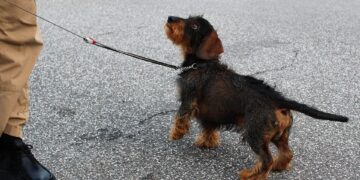Conquer the Pull: The Ultimate Guide to Harnesses for Strong-Willed Dogs
Having a strong-willed dog can be both challenging and rewarding. While these dogs are often intelligent and independent, they can also be stubborn and difficult to control, especially when it comes to walking on a leash. If you’re struggling to keep your strong-willed pup from pulling on walks, investing in a high-quality harness can make all the difference. In this comprehensive guide, we’ll explore the different types of harnesses available for strong-willed dogs, how to choose the right one for your furry friend, and tips for using a harness effectively to conquer the pull.
Why Use a Harness for Strong-Willed Dogs?
Before we dive into the details of harnesses for strong-willed dogs, let’s first discuss why using a harness is beneficial for these types of dogs. Unlike traditional collars, which can put pressure on a dog’s neck and throat when they pull, harnesses distribute the pressure more evenly across the dog’s chest and back. This can help prevent injuries and discomfort, especially for dogs that tend to pull on walks. Additionally, harnesses give you more control over your dog’s movements, making it easier to redirect their attention and keep them from pulling.
Types of Harnesses for Strong-Willed Dogs
There are several types of harnesses available for strong-willed dogs, each with its own unique features and benefits. Here are some of the most popular options:
Front-Clip Harnesses:
Front-clip harnesses have a ring on the front of the dog’s chest where you can attach the leash. When your dog pulls, the harness will turn their body to the side, making it harder for them to continue pulling forward. Front-clip harnesses are great for strong-willed dogs because they provide more control and discourage pulling behavior.
Back-Clip Harnesses:
Back-clip harnesses have a ring on the dog’s back where you can attach the leash. While these harnesses are easier to put on and take off, they may not be as effective at preventing pulling as front-clip harnesses. Back-clip harnesses are better suited for dogs that don’t pull as much or for training purposes.
No-Pull Harnesses:
No-pull harnesses are specifically designed to discourage pulling behavior. These harnesses often have additional features, such as a chest strap that tightens when the dog pulls or a martingale loop that provides gentle pressure on the dog’s chest. No-pull harnesses can be a great option for strong-willed dogs that have a tendency to pull on walks.
Choosing the Right Harness for Your Strong-Willed Dog
When selecting a harness for your strong-willed dog, there are several factors to consider to ensure you choose the right one for your furry friend. Here are some tips for choosing the perfect harness:
Size and Fit:
It’s essential to choose a harness that fits your dog correctly to ensure their comfort and safety. Measure your dog’s chest and neck circumference and compare it to the harness’s size chart to find the right fit. Make sure the harness is snug but not too tight, and check for any rubbing or chafing that could cause irritation.
Material:
Harnesses come in a variety of materials, including nylon, leather, and mesh. Consider your dog’s activity level and comfort preferences when selecting a material. Nylon harnesses are durable and easy to clean, while leather harnesses are stylish and long-lasting. Mesh harnesses are lightweight and breathable, making them ideal for hot weather.
Features:
Look for harnesses with features that cater to your dog’s specific needs. For example, if your dog tends to pull, a front-clip or no-pull harness may be the best option. If your dog has sensitive skin, choose a harness with padding or soft lining to prevent irritation. Consider additional features like reflective stitching for nighttime visibility or adjustable straps for a customizable fit.
Tips for Using a Harness Effectively
Once you’ve chosen the perfect harness for your strong-willed dog, it’s essential to use it effectively to conquer the pull. Here are some tips for using a harness with your dog:
Proper Fit:
Ensure the harness is fitted correctly and adjusted to your dog’s size. The harness should be snug but not constricting, with enough room for your dog to move comfortably. Check the fit regularly, especially as your dog grows or gains/loses weight.
Positive Reinforcement:
Use positive reinforcement techniques to encourage good walking behavior. Reward your dog with treats, praise, or toys when they walk nicely on a loose leash. Avoid using harsh corrections or punishments, as this can create fear or anxiety in your dog.
Consistency:
Be consistent in your training and use the harness every time you walk your dog. Consistency is key to reinforcing good behavior and breaking bad habits. Stick to a routine and practice walking with your dog regularly to see the best results.
Patience:
Training a strong-willed dog takes time and patience. Be patient with your dog and yourself as you work together to conquer the pull. Remember that progress may be slow, but with dedication and consistency, you can help your dog become a better walker.
Conclusion
Conquering the pull with a strong-willed dog doesn’t have to be a daunting task. By investing in the right harness and using it effectively, you can transform your walks from frustrating to enjoyable for both you and your furry friend. Remember to choose a harness that fits your dog correctly, offers the right features, and use positive reinforcement techniques to encourage good behavior. With patience and consistency, you can conquer the pull and enjoy stress-free walks with your strong-willed dog.














































